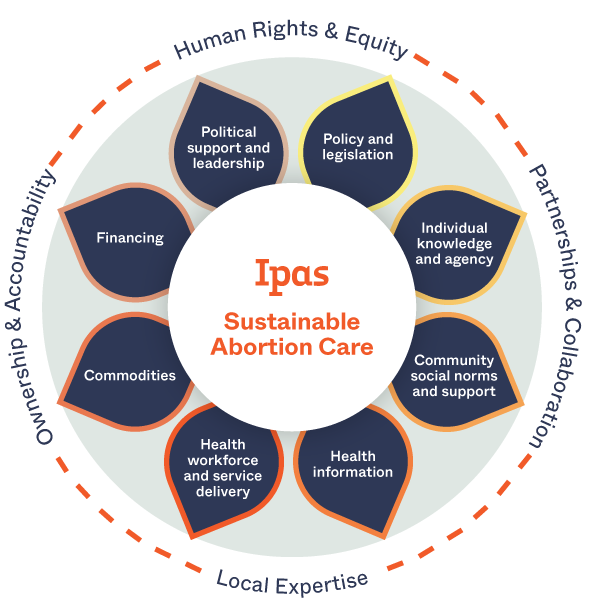This resource is for health professionals. If you’re seeking personal health information about abortion with pills, go here: www.ipas.org/abortionwithpills
Last reviewed: September 23, 2022
Recommendation:
- Exposure to mifepristone alone has not been shown to cause fetal malformations. Exposure to misoprostol is associated with a small increased risk of malformations if the person has an ongoing pregnancy and decides not to terminate. Individuals with an ongoing pregnancy after using misoprostol should be counseled about the risk if they choose to continue the pregnancy.
Strength of recommendation: Strong
Quality of evidence:
- Mifepristone: Very low
- Misoprostol: Very low
Background
The expected rate of fetal malformations in the general population is approximately 3% (Dolk, Loane, & Garne, 2010). Exposure to certain medications, infections, radiation or drugs of abuse during embryonic or fetal development may result in an increased risk of malformations if the pregnancy continues.
Mifepristone
Data on continuing pregnancy after mifepristone exposure without misoprostol are limited. The largest prospective study of 46 women continuing a pregnancy after mifepristone resulted in eight miscarriages and, in the pregnancies that continued, two major malformations (5.3%). Neither malformation was thought to be related to mifepristone exposure but may have been a result of other medical conditions (Bernard et al., 2013).
Misoprostol
Case reports, cohort studies (da Silva Dal Pizzol et al., 2005; Vauzelle et al., 2013) and case-control studies (da Silva Dal Pizzol, Knop, & Mengue, 2006) show that the incidence of malformations peaks if misoprostol is used between 5-8 weeks after the last menstrual period (LMP) and is not associated with anomalies following exposure after 13 weeks following an individual’s LMP (Philip, Shannon, & Winikoff, 2002). The most typical malformations associated with misoprostol use are Mobius sequence, a rare disorder of cranial nerve palsies associated with limb anomalies and craniofacial defects, and terminal transverse limb defects (da Silva Dal Pizzol, et al., 2006). Although not clearly established, the proposed mechanism is vascular disruption from uterine contractions leading to disordered fetal development (Gonzalez et al., 2005; Shepard, 1995).
A systematic review of four case-control studies with 4,899 cases of congenital anomalies and 5,742 controls showed an increased rate of misoprostol exposure in cases with anomalies (da Silva Dal Pizzol, et al., 2006). Misoprostol exposure was 25 times more likely in cases with Mӧbius sequence and 12 times more likely in cases with terminal transverse limb defects. In a cohort of 183 women exposed to misoprostol during the first 12 weeks of pregnancy, the major malformation rate was 5.5%; half of these were consistent with misoprostol malformation patterns (Auffret et al., 2016). However, a prospective follow-up study comparing women who used misoprostol before 12 weeks of pregnancy to women who used antihistamines did not find a statistically significant difference in the rate of fetal malformations, although three malformations (2%) in the misoprostol group were consistent with misoprostol-related anomalies (Vauzelle, et al., 2013).
Although the rate of misoprostol exposure is higher in children born with characteristic defects such as Mӧbius sequence, the anomalies are so rare that the overall risk is low that a woman who takes misoprostol before 13 weeks gestation and carries a pregnancy to term will have a child born with a malformation related to misoprostol exposure. The risk of fetal malformation related to misoprostol exposure is less than 10 per 1,000 exposures (Philip, et al., 2002).
References
Auffret, M., Bernard-Phalippon, N., Dekemp, J., Carlier, P., Gervoise Boyer, M., Vial, T., & Gautier, S. (2016). Misoprostol exposure during the first trimester of pregnancy: Is the malformation risk varying depending on the indication? European Journal of Obstetrics & Gyncelology and Reproductive Biology, 207, 188-192.
Bernard, N., Elefant, E., Carlier, P., Tebacher, M., Barjhoux, C., Bos‐Thompson, M., & Vial, T. (2013). Continuation of pregnancy after first‐trimester exposure to mifepristone: An observational prospective study. BJOG: An International Journal of Obstetrics & Gynaecology, 120(5), 568-574.
da Silva Dal Pizzol, T., Knop, F. P., & Mengue, S. S. (2006). Prenatal exposure to misoprostol and congenital anomalies: Systematic review and meta-analysis. Reproductive Toxicology, 22(4), 666-671.
da Silva Dal Pizzol, T., Tierling, V. L., Schüler-Faccin, L., Sanseverino, M. T. V., & Mengue, S. S. (2005). Reproductive results associated with misoprostol and other substances utilized for interruption of pregnancy. European Journal of Clinical Pharmacology, 61(1), 71-72.
Dolk, H., Loane, M., & Garne, E. (2010). The prevalence of congenital anomalies in Europe. Rare Diseases Epidemiology, 349-364.
Gonzalez, C. H., Vargas, F. R., Perez, A. B. A., Kim, C., Brunoni, D., Marques‐Dias, M. J., & de Almeida, J. C. C. (2005). Limb deficiency with or without Möbius sequence in seven Brazilian children associated with misoprostol use in the first trimester of pregnancy. American Journal of Medical Genetics, 47(1), 59-64.
Philip, N. M., Shannon, C., & Winikoff, B. (2002). Misoprostol and teratogenicity: Reviewing the evidence. New York: Population Council.
Shepard, T. H. (1995). Möbius syndrome after misoprostol: A possible teratogenic mechanism. The Lancet, 346(8977), 780.
Vauzelle, C., Beghin, D., Cournot, M.-P., & Elefant, E. (2013). Birth defects after exposure to misoprostol in the first trimester of pregnancy: Prospective follow-up study. Reproductive Toxicology, 36, 98-103.
